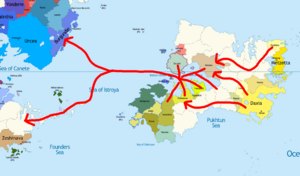Pre-modern global trade
| This article is a stub. You can help IxWiki by expanding it. |

Sea of Istroya trade network
The main participants in Ancient Istroyan commerce were the class of traders known as emporoi (ἕμποροι). The states collected a duty on their cargo, typically at 1% or higher. By the end of the 5th century, the tax had been raised to 33 talents in more high-use ports. The growth of trade in Ancient Istroya led to the development of financial techniques. Most merchants, lacking sufficient cash assets, resorted to borrowing to finance all or part of their expeditions. A typical loan for a large venture in 4th century BC, was generally a large sum of cash (usually less than 2,000 drachmas), lent for a short time (the length of the voyage, a matter of several weeks or months), at a high rate of interest (often 12% but reaching levels as high as 100%). The terms of the contract were always laid out in writing, differing from loans between friends (eranoi). The lender bore all the risks of the journey, in exchange for which the borrower committed his cargo and his entire fleet, which were precautionarily seized upon their arrival at the port the loan was offered. Trade in Ancient Istroya was typically free. One of the main drivers of trade in Ancient Greece was colonization. As larger city states set up colonies, there would be trade between the founding city and its colony. Furthermore, differing climates between cities and their respective colonies created comparative advantages in goods. For example, colonies in Sicily would often have better weather and be able to export grain to more populous cities. Larger city states often exported more value added goods, such as olive oil, back out to colonies. The number of shipwrecks found in the Mediterranean Sea provides valuable evidence of the development of trade in the ancient world. Only two shipwrecks were found that dated from the 8th century BC. However, archaeologists have found forty-six shipwrecks dated from the 4th century BC, which would appear to indicate that there occurred a very large increase in the volume of trade between these centuries. Considering that the average ship tonnage also increased in the same period, the total volume of trade increased probably by a factor of 30.
Spice trade
Salt trade
Silk Road
The Silk Road was a network of Audonian trade routes active from the second century BCE until the mid-19th century. It played a central role in facilitating economic, cultural, political, and religious interactions between the East and West. The name "Silk Road", was first coined in the late 17th century, by a Daxian historian who was chronicling the history of the Qian empire. His book was published in some of the Burgoignesc colonies in South Eastern Audonia and soon the term Silk Road became ubiquitous.